 |
|
 |
 |
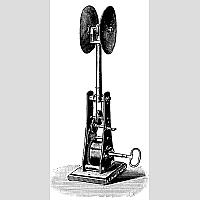 |
Color sensitometer with clockwork
(Farbenkreisel mit Uhrwerk)
|
1923 |
|
taken from: Zimmermann, E. 1923. Liste 33: Über Psychotechnik.
(p. 0005, fig. 160) |


|
 |
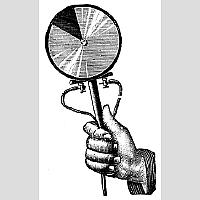 |
Color sensitometer with electric motor. (Wdt. II. 174.) with the advantage of great handiness and comfortable operation, running silent and constantly by electricity, with low current consumption. The apparatus can be presented in ratation in every positions, due to its lightness it is especially suitable for lecture demonstrations in the auditorium. By a small string connection the motor can be used for direct drive. Winded for light and heavy current of 110 or 220 volt tension. 1,900 kg. In the case of orders without special wishes of winding types, motors for light current are delivered.
(Farbenkreisel mit Elektromotor. (Wdt. II. 174.))
|
1923 |
|
taken from: Zimmermann, E. 1923. Liste 33: Über Psychotechnik.
(p. 0006, fig. 165) |


|
 |
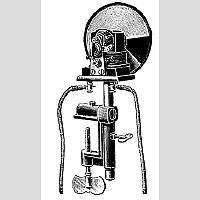 |
Color sensitometer with electric motor, mounted on a table clamp, the installation is rotatable on its longitudinal axis as well; 2,500 kg.
(Farbenkreisel mit Elektromotor, montiert in Tischklemme und auch hierin drehbar um seine Längsachse; kg 2,500.)
|
1923 |
|
taken from: Zimmermann, E. 1923. Liste 33: Über Psychotechnik.
(p. 0007, fig. 167) |


|
 |
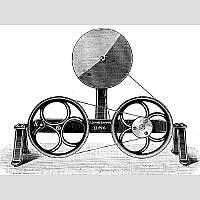 |
Color sensitometer for manual drive. The disc axis is mounted on a frame and a high number of rotation can be reached by a multiplex string transmission. The two lower transmission wheels are adjustable to tension the string; 6,700 kg.
(Farbenkreisel für Handbetrieb.)
|
1923 |
|
taken from: Zimmermann, E. 1923. Liste 33: Über Psychotechnik.
(p. 0007, fig. 170) |


|
 |
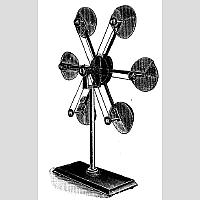 |
Sevenfold color sensitometer according to Michotte. Around a motor driven median axis 6 axises are driven by the same speed by a string drive centered in the medium axis. All axises serve for the insertion of color disc. In the centre a saturated color can be produced, then the 3 pairs of discs (2 opposites are one pair) show 3 variations. So the change of color quality can be presented. Moreover different grades of saturation and luminosity may be demonstrated as well as the mixture of all colors can be produced. Every string drive can be tensioned by the shift of the axis; 5,800 kg.
(Siebenfacher Farbkreisel nach Michotte)
|
1923 |
|
taken from: Zimmermann, E. 1923. Liste 33: Über Psychotechnik.
(p. 0008, fig. 189) |


|
 |
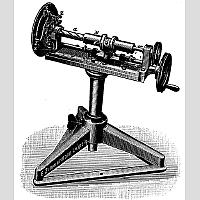 |
Color sensitometer for the optional adjustment of the sectors during the rotation. This color sensitometer serves for the same purpose like Marbe's rotatory apparatus: Readjustment of the proportions of the sectors of two telescoped color discs during the rotation. This apparatus differs from the other by the use of an axis with spiral slots according to the method by Lummer-Brodhun (Zeoitschr. f. Instrkd. 1896), that can be moved within a casing tube N for- and backwards by a setting screw R, instead of neither a string nor a lead roll. By the guide slot a rotation counterwise the wave W with the string drive can be produced during the for- and backward movements. The one of the color discs is connected with the wave W, the second one with the casing tube N. A full rotation of the last one can be produced be a 72 mm forward movement of the casing tube. The proportion of the sectors changes for 5 degrees with every millimeter. As the head of the screw R is gratuated into 10 intervals, the proportion of the sectors can be adjusted up to 1/2 degree during the rotation, what is indicated on the scale S; 7,300 kg.
(Farbenkreisel zur beliebigen Verstellung der Sektoren während der Rotation)
|
1923 |
|
taken from: Zimmermann, E. 1923. Liste 33: Über Psychotechnik.
(p. 0009, fig. 215) |


|
 |
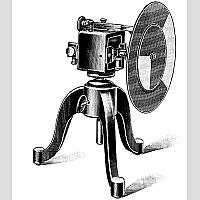 |
Color variator on tripod. Due to the arrangement on the motor axis the security of operation is guaranteed. During the operation the telescoping of the sectors is produced by a knurled-head screw. 30 graduation on the guiding ways as well as one of 12 gratuations on the screwhead permit an adjustment of the sectors of 1 degree. The motor runs with heavy current only. Please note the voltage of your power source; 6,000 kg.
(Farbvariator auf Dreifuß)
|
1923 |
|
taken from: Zimmermann, E. 1923. Liste 33: Über Psychotechnik.
(p. 0010, fig. 218) |


|
 |
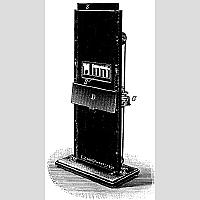 |
Simple droptachistoscope to produce momentary facial impressions. The parachute S, of which the velocity of speed can be influenced by G, gives view on a normally covered object for the time of passing by the crack. The crack has an opening of 150x60mm, that can be constricted by shifters. The apparatus is completely metalic. In case of repetitions of the experiment the stimulating card is covered by a hinged lid; 6,200 kg.
(Tachistoskop, einfacher Apparat, zur Erzeugung momentaner Gesichtseindrücke)
|
1923 |
|
taken from: Zimmermann, E. 1923. Liste 33: Über Psychotechnik.
(p. 0011, fig. 590) |


|
 |
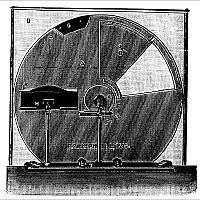 |
Rotatory-tachistoscope. The image shows the backside of the apparatus to explain the operation: The parachute, of which the crack B gives view to
the stimulating card (object) for a certain (by the adjustment of B variable) time, is constructed by a disc V, that is swung by an overweight G. Near the axis the same one is limited by 2 noses F, which snap to the catch spring C. By pulling back C F1 is given free and the disc swings around by this weight effect until the nose N snaps to the catch spring C. During that process the object R becomes visible and can be seen throught the corresponding opening in the parachute D, that normally covers the whole mechanism. The opening D resp. the size of the object is 240x60mm. The object mount can be tilt for an easier change of the stimulating cards. One special advantage of the tachistoscope is that the object needs not to be covered in the following demonstration. The disc is turned on the same direction up to the start position. The stimulating demonstration is noiseless; 10,200 kg.
(Rotations-Tachistoskop)
|
1923 |
|
taken from: Zimmermann, E. 1923. Liste 33: Über Psychotechnik.
(p. 0012, fig. 600) |


|
 |
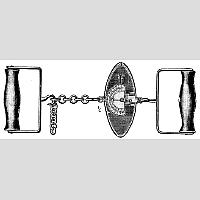 |
Dynamometer according to Andrew for to pull. It also serves as a simple dynamometer; 0,240 kg.
(Dynamometer nach Andrew zum Ziehen. Auch als einfacher Dynamometer verwendbar; kg 0,240.)
|
1923 |
|
taken from: Zimmermann, E. 1923. Liste 33: Über Psychotechnik.
(p. 0023, fig. 1074) |


|
 |
|
 |